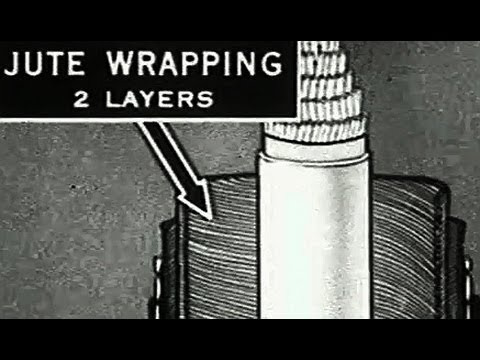more at
A submarine telephone cable is laid in San Francisco Bay. The layered insulation of the underwater cable is described and shown in animated graphics.
NEW VERSION with improved video & sound:
Public domain film from the Prelinger Archive, slightly cropped to remove uneven edges, with the aspect ratio corrected, and mild video noise reduction applied.
The soundtrack was also processed with volume normalization, noise reduction, clipping reduction, and/or equalization (the resulting sound, though not perfect, is far less noisy than the original).
A submarine communications cable is a cable laid on the sea bed between land-based stations to carry telecommunication signals across stretches of ocean. The first submarine communications cables, laid in the 1850s, carried telegraphy traffic. Subsequent generations of cables carried telephone traffic, then data communications traffic. Modern cables use optical fiber technology to carry digital data, which includes telephone, Internet and private data traffic.
Modern cables are typically 69 millimetres (2.7 in) in diameter and weigh around 10 kilograms per metre (7 lb/ft), although thinner and lighter cables are used for deep-water sections. As of 2010, submarine cables link all the world’s continents except Antarctica.
Trials
After William Cooke and Charles Wheatstone had introduced their working telegraph in 1839, the idea of a submarine line across the Atlantic Ocean began to be thought of as a possible triumph of the future. Samuel Morse proclaimed his faith in it as early as 1840, and in 1842, he submerged a wire, insulated with tarred hemp and India rubber, in the water of New York Harbor, and telegraphed through it…
The first commercial cables
Having earlier obtained a concession from the French Government, in August 1850 John Watkins Brett’s Anglo-French Telegraph Company laid the first line across the English Channel, using the converted tug Goliath. It was simply a copper wire coated with gutta-percha, without any other protection, and was not successful. The experiment served to secure renewal of the concession, and in September 1851, a protected core, or true, cable was laid by the reconstituted Submarine Telegraph Company from a government hulk, the Blazer, which was towed across the Channel…
Transatlantic telegraph cable
The first attempt at laying a transatlantic telegraph cable was promoted by Cyrus West Field, who persuaded British industrialists to fund and lay one in 1858. However, the technology of the day was not capable of supporting the project; it was plagued with problems from the outset, and was in operation for only a month. Subsequent attempts in 1865 and 1866 with the world’s largest steamship, the SS Great Eastern, used a more advanced technology and produced the first successful transatlantic cable. The Great Eastern later went on to lay the first cable reaching to India from Aden, Yemen, in 1870…
Construction
Transatlantic cables of the 19th century consisted of an outer layer of iron and later steel wire, wrapping India rubber, wrapping gutta-percha, which surrounded a multi-stranded copper wire at the core. The portions closest to each shore landing had additional protective armor wires. Gutta-percha, a natural polymer similar to rubber, had nearly ideal properties for insulating submarine cables, with the exception of a rather high dielectric constant which made cable capacitance high. Gutta-percha was not replaced as a cable insulation until polyethylene was introduced in the 1930s. In the 1920s, the American military experimented with rubber-insulated cables as an alternative to gutta-percha, since American interests controlled significant supplies of rubber but no gutta-percha manufacturers…
Transatlantic telephony
While laying a transatlantic telephone cable was seriously considered from the 1920s, the technology required for economically feasible telecommunications was not developed until the 1940s…
TAT-1 (Transatlantic No. 1) was the first transatlantic telephone cable system. Between 1955 and 1956, cable was laid between Gallanach Bay, near Oban, Scotland and Clarenville, Newfoundland and Labrador. It was inaugurated on September 25, 1956, initially carrying 36 telephone channels…

